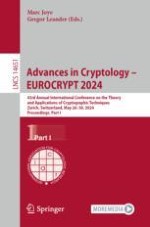The 7-volume set LNCS 14651 - 14657 conference volume constitutes the proceedings of the 43rd Annual International Conference on the Theory and Applications of Cryptographic Techniques, EUROCRYPT 2024, held in in Zurich, Switzerland, in May 2024.
The 105 papers included in these proceedings were carefully reviewed and selected from 500 submissions. They were organized in topical sections as follows:
Part I: Awarded papers; symmetric cryptology; public key primitives with advanced functionalities;
Part II: Public key primitives with advances functionalities;
Part III: AI and blockchain; secure and efficient implementation, cryptographic engineering, and real-world cryptography; theoretical foundations;
Part IV: Theoretical foundations;
Part V: Multi-party computation and zero-knowledge;
Part VI: Multi-party computation and zero-knowledge; classic public key cryptography,
Part VII: Classic public key cryptography.
